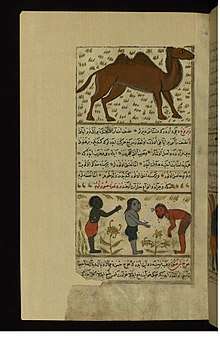Nasnas
In Arab folklore, the Nasnas (Arabic: النَّسْنَاس an-nasnās) is a monstrous creature. According to Edward Lane, the 19th century translator of The Thousand and One Nights, a nasnas is "half a human being; having half a head, half a body, one arm, one leg, with which it hops with much agility". [1]

And also in Somali folklore there is a creature called "xunguruuf" "Hungruf" which resembles the "nasnās" as it has the same characteristics and features. It's believed it can kill a person by just touching them and the person would be fleshless in mere seconds.
It was believed to be the offspring of a demon called a Shiqq (الشق) and a human being. [1] A character in "The Story of the Sage and the Scholar", a tale from the collection, is turned into a nasnas after a magician applies kohl to one of his eyes. The nasnas is mentioned in Gustave Flaubert's The Temptation of Saint Anthony.
See also
Sources
- Robert Irwin The Arabian Nights: a Companion (Penguin, 1994)
- Jorge Luis Borges The Book of Imaginary Beasts (Penguin, 1974)